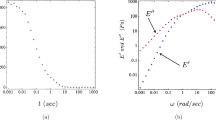Abstract
One of the basic problems of structural-model analysis, model photoelasticity and photoelastic coatings in the problem of mechanical and optical creep, relaxation and related phenomena. It is pointed out that, in spite of creep or relaxation, it is possible to achieve physical similarity between model and object if the model material behaves in a certain range as a linear viscoelastic material. Such a material is called a “momentarily linear material.” Several model materials behave in this way in a certain range of stress and time.
Because of creep and relaxation, the common tensile tests are, in general, not quite adequate for evaluation of physical properties of plastics used for models. Also the bending test is not always adequate. It is shown how to obtain sufficiently accurate relations between stress, strain, birefringence and time, using tapered specimens.
The problem of biaxial creep of model materials is discussed, and a simple method of evaluating the suitability of a given plastic as a model material is shown. Some conclusions concerning time-dependent factors are formulated, and some possible areas of investigation are shown.
Similar content being viewed by others
Abbreviations
- (E) t :
-
time-dependent value of the elasticity modulus
- m :
-
order of isochromatic
- S ε :
-
material strain-fringe value
- \(\left( {S_\sigma } \right)_t \) :
-
time-dependent material stress-fringe value
- t :
-
time
- ε:
-
strain
- \( \in _{ \in l} \) :
-
elastic strain
- \( \in _{in} \) :
-
inelastic strain
- σ:
-
stress
- d :
-
thickness of model
- R :
-
relative retardation
- λ:
-
wavelength of light
- D :
-
dispersion of birefringence
- \(\sigma _1 \) :
-
creep, stress level 1 (Fig. 1c)
- \(\sigma _2 \) :
-
creep, stress level 2 (Fig. 1c)
- (σ)0 :
-
creep recovery, after creep at stress σ (Fig. 1c)
- (σ 1)0 :
-
creep recovery, after creep at stressσ 1 (Fig. 1c)
- (σ 2)0 :
-
creep recovery, after creep at stressσ 2 (Fig. 1c)
- m 0 :
-
isochromatic order immediately (less than 0.1 sec) after loading or unloading (Fig. 5)
- m end :
-
isochromatic order before unloading (1–60 sec before), or at the end of the test (Fig. 5)
- dm/dt :
-
rate of optical creep (Fig. 5)
References
Wilbur, J. B., andNorris, C. H., “Structural Model Analysis,”Handbook of Experimental Stress Analysis, ed., M. Hetényi, John Wiley & Sons, New York (1954).
Prigorovski, N. I., andPreiss, A. K., “Investigation of Stresses and Stiffnesses in Machine Parts by Application of Extensometric Models,”in Russian.Izdatelstvo Akademii Nauk SSSR, Moskva (1958).
Persoz, B., and others, Introduction a l'étude de la rhéologie, Dunod, Paris (1960).
Föppl, L., andMönch, E., Praktische Spannungsoptik, Spriger Verlag, Berlin (1950).
Noel, M. C., Études sur modèles réduits. Emploi d'une famille de Résines Polyesters pour la construction des modèles réduits, Les stratyls A 16 et A 34, Analyse des Contraintes. Mémoires du GAMAC. Paris, No. 3 (1960).
Pindera, J. T., “Remarks about Method of Combining Stress-concentration Factors” in Polish, Rozprawy Inzynierskie, No. 4 (1956).
Pindera, J. T., “Investigations of the Rheological Photoelastic Properties of Some Polyester Resins” in Polish, Rozprawy Inzynierskie, Nos. 3 and 4 (1959).
Pindera, J. T., “On Some Criteria of Evaluation of Model Materials,” report on Second International Conference on Experimental Stress Analysis, Paris (1962).
Pindera, J. T., “Rheological Properties of Model Materials,” in Polish, Wydawnictwa Naukowo-Techniczne, Warszawa (1962) (will be translated into English).
Kuske, A., “Multiphase Theory of Plastics,”Experimental Mechanics,2(9),278–280 (1962).
Hiltscher, R., “Theorie and Anwendung der Spannungsoptik im elastoplastischen Gebiet,” VDI Zeitschrift No. 2 (1955).
Javornický, J., “Concerning the Double Nature of Birefringence in Plastics,”Experimental Mechanics,3(7),175–176 (1963).
Pindera, J. T., “Contemporary Methods of Photoelasticity,”in Polish, Panstwowe Wydawnictwa Techniczne, Warszawa (1960).
Mönch, E., “Die Dispersion der Doppelbrechung als Plastizitätsmass in der Spannungsoptik,” Z. angew. Phys., Heft 8 (1954).
Oppel, G. U., andPeterson, H. A., “Experimental Techniques Employed for Photoelastic Analysis of Cellular Shells,”Experimental Mechanics,3(8),184–191 (1963).
Kufner, M., “Werkstoffe fur spannungsoptische Modelle,” Zeitschrift für angew, Physik, 7 Heft (1962).
Jira, T., “Das mechanische und spannungsoptische Verhalten von Zelluloid bei zweiachsiger Beanspruchung,” Konstruktion, Heft 11 (1957).
Loreck, R., “Untersuchung von Polyestergiessharzen und anderen Kunststoffen auf ihre Eignung als photoplastisches Modellmaterial,” Kunststoffe, Heft 3 (1962).
Mönch, E., “Similarity and Model Laws in Photoelastic Experiments,”Experimental Mechanics,4(5),141–150 (1964).
Stuart, H. A., “Die Physik der Hochpolymeren,”Vierter Band, Springer Verlag, Berlin (1956).
Author information
Authors and Affiliations
Additional information
Jerzy T. Pindera was Visiting Professor of Mechanics, Department of Metallurgy, Mechanics and Materials Science, Michigan State University, East Lansing, Mich. at time that paper was prepared
Rights and permissions
About this article
Cite this article
Pindera, J.T. Remarks on properties of photoviscoelastic model materials. Experimental Mechanics 6, 375–380 (1966). https://doi.org/10.1007/BF02327215
Issue Date:
DOI: https://doi.org/10.1007/BF02327215




